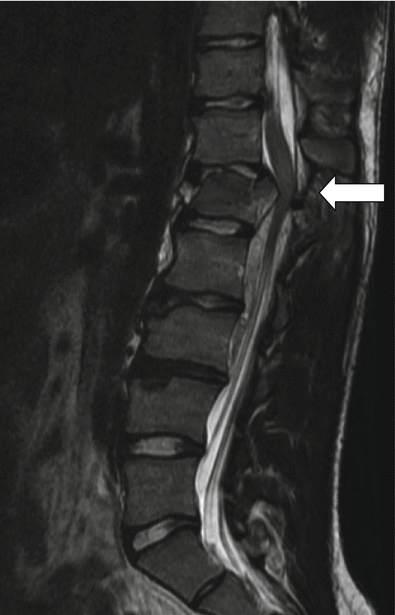Figure 8.1
CT scan of the head in an elderly patient who fell. See the blood clot on the surface of the brain on the right side and some bruising of the brain (contusions) on the left. See also how the brain has been pushed from the right to the left (midline shift)
Spinal Injury
Spinal injury is one of the most devastating injuries seen in trauma patients. Spine injury occurs most commonly in sports injuries, motor vehicle accidents, and falls. The spine itself consists of multiple bones (vertebrae) that surround and protect the spinal cord. A pair of nerves exits at each level on each side. The results of spinal cord injury depends on the both the level and the severity of the injury. Below the level of injury the patient may have weakness or paralysis of the muscles, decreased sensation, and loss of bladder and bowel function. Therefore the higher the level, the more disabling the injury is likely to be. An injury in the neck or cervical spine would affect both the upper and lower extremities while one lower in the spine may only affect the lower extremities.
Fractures or a breakage of the spinal vertebrae can potentially result in spinal misalignment and instability. This misalignment can lead to compression of the spinal cord itself, or the exiting nerves and result in neurologic injury. Spinal cord injury can also occur from bruising or from compression of the cord by a hematoma. The primary goal in these situations is to restore the proper alignment of the spine and remove compression on the spinal cord and nerves. This can be done by pulling the spine straight (traction) or by surgery. The secondary goal after decompression is to restore the stability of the spine to prevent further spinal cord compression. In these cases, before definitive surgical stabilization can be undertaken, it is important to provide external stabilization of the spine with external braces to minimize motion to the area where the spine is unstable. These patients may have to be monitored in an intensive care unit to optimize blood pressure to ensure that the spinal cord is receiving enough blood to maximize the potential for recovery (Fig. 8.2).


Figure 8.2
MRI of a patient who was involved in car accident. Note the displacement of the Lumbar 1 vertebra causing cord compression of the lower end of the spinal cord
Ischemic Stroke
An ischemic stroke occurs when the brain does not receive enough oxygen because of a lack of blood flow. The main cause of ischemic stroke is a blockage of a blood vessel from narrowing due to plaque formation, or a blood clot that forms at a plaque of a heart valve and flows downstream to occlude an artery that supplies the brain. Risk factors for developing strokes include advanced age, high blood pressure, high cholesterol, diabetes, blood clotting disorders, dehydration and smoking. The signs and symptoms of stroke will depend on what part of the brain is affected. Common symptoms include weakness on one side of the body, facial droop, and slurred speech. The onset is typically painless and the symptoms usually appear suddenly, although sometimes in a staggered manner. If a stroke is detected soon enough, a patient may qualify for a drug (tPA) that can break up the blood clot and perhaps prevent brain injury. This medication has shown only to be beneficial if given within the first few hours of stroke onset and carries the risk of causing further bleeding into the brain. After a stroke, it is important to optimize blood pressure to maintain adequate blood flow in order to help with recovery.
Stay updated, free articles. Join our Telegram channel

Full access? Get Clinical Tree






